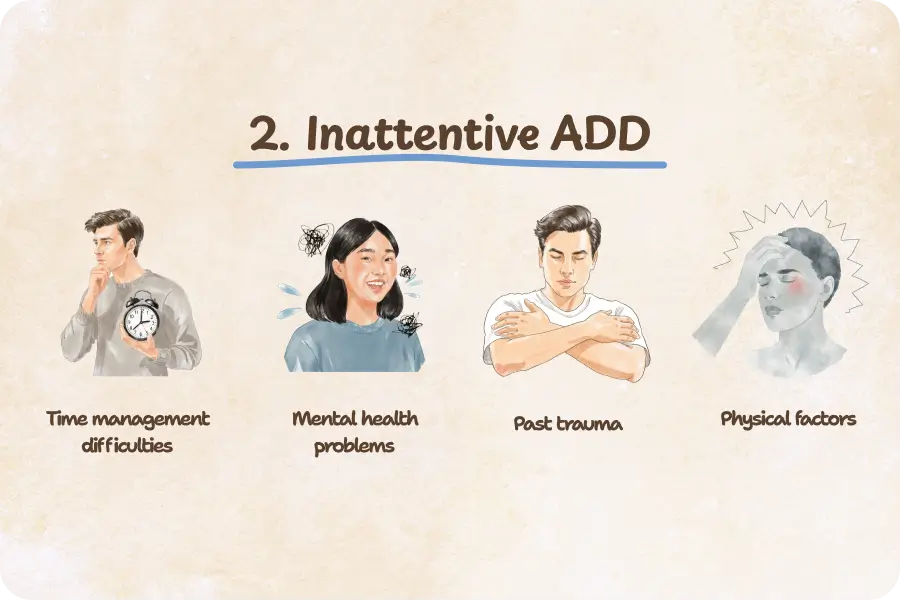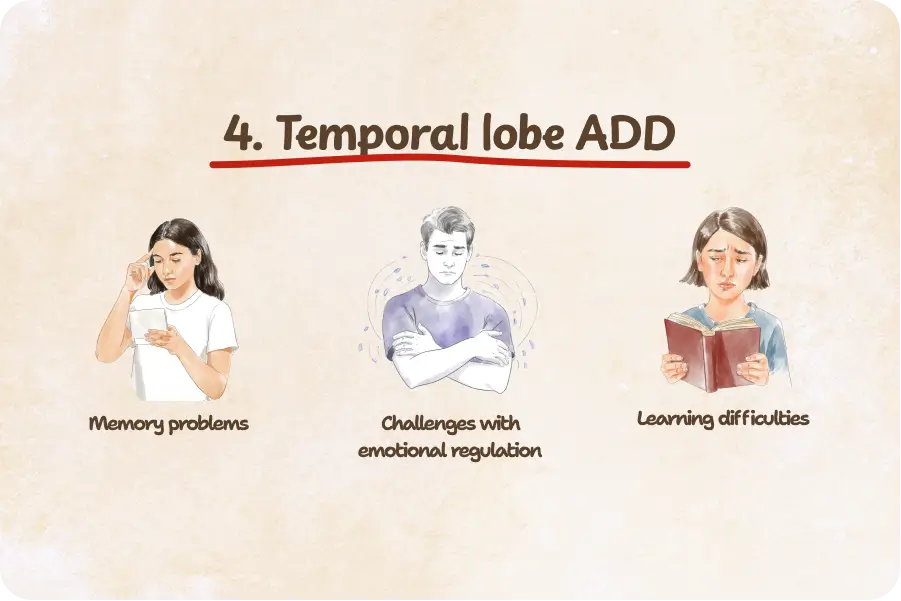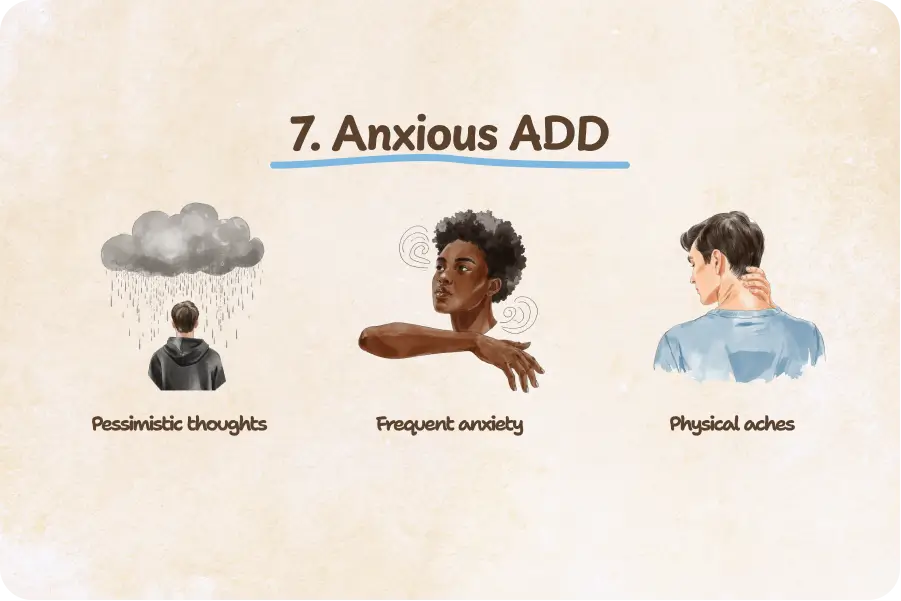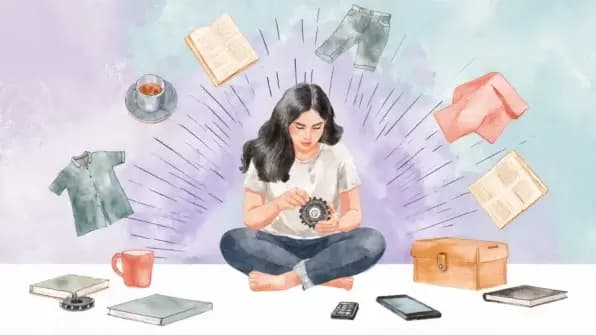ADHD symptoms can manifest differently from person to person. While some may feel completely relatable, others can seem foreign to you. This may be because the 7 types of ADHD in adults vary greatly, and you might experience specific challenges depending on the type you live with.
As such, this overview draws insights from Dr. Daniel G. Amen’s book, “Healing ADD: The Breakthrough Program that Allows You to See and Heal the 7 Types of ADD.”
These types are not described in the Diagnostic and Statistical Manual of Mental Disorders (DSM-5), but due to Dr. Amen’s expertise as a psychiatrist and nuclear brain imaging specialist, they are worth discussing.
7 types of ADD and their core symptoms
According to Dr. Amen, the 7 types of attention deficit disorder include classic ADD, inattentive ADD, over-focused ADD, temporal lobe ADD, limbic ADD, ring of fire ADD, and anxious ADD. Let’s explore each one in detail.
1. Classic ADD
Classical ADD is characterized by inattention, hyperactivity, and impulsivity. This type of condition is what many people tend to think about when someone says “ADHD,” as it involves all visible symptoms. For those with classic ADD, it’s challenging to stay on task, remain still, or think before acting. Additional symptoms and underlying challenges may include:
- Problems with organizing things and tasks
- Excessive talking
- Trouble listening
- Boundless energy
- Chronic low-level sadness
- Weak planning skills
Bart Simpson from The Simpsons may serve as an example of this type. He is impulsive, lacks focus in school, and is constantly in need of excitement. Bart finds it challenging to stay on task, follow rules, and manage energy.
Of course, we can’t diagnose a fictional character and identify his ADHD type. But all of these behaviors, as well as difficulties in completing chores, can be indicative of classic ADD.

2. Inattentive ADD
Dr. Amen, in his book, states that this is the second most common type of ADD. While it doesn’t involve hyperactive behavior or impulsivity, inattentive behavior is a notable characteristic. The main inattentive ADD symptoms are short attention span, frequent daydreaming, slow movement, and time management difficulties.
People living with this type may be introverted and quiet. Interestingly, because inattentive ADD may not cause extreme problems in daily functioning, many people find out about their condition in adulthood. Also, people with ADD inattentive type may:
- Have trouble focusing and get easily distracted
- Procrastinate
- Experience time management problems
- Tend to lose their possessions
- Find it difficult to pay attention when others talk
- Engage in stimming
- Have difficulty paying attention to detail
Those with ADD inattentive type might seem apathetic and move quite slowly, so others may think of them as unmotivated. However, chronic fatigue is another symptom of this disorder.
Daria Morgendorffer from the animated sitcom Daria can be a perfect example. She experiences difficulty focusing, is easily distracted, and appears unmotivated. Also, Daria tends to daydream and grapples with organization and time management. These signs align well with the characteristics of inattentive ADD, which is typical for women with ADD.

3. Over-focused ADD
The over-focused ADD type is characterized by dwelling on negative thoughts and being unable to shift one’s focus. It is pretty similar to the classic one, but people living with this type may also get stuck on specific tasks, thought patterns, or behaviors, which can lead to excessive worrying. Additional symptoms of this type of ADHD are:
- Hyperfixation
- Obsessive and compulsive behavior
- Inflexibility
- Holding grudges
- Feeling upset if something happens differently than they expected
- Maintaining their own opinions and ignoring others
While people with ADHD may find it difficult to shift their attention or stay on task, they can also become incredibly absorbed in activities they find fascinating. Also, those with over-focused ADD may or may not exhibit hyperactivity. It sounds contradictory, but it’s actually a quirk of ADHD, particularly the third type.
An example of a character with over-focused ADD is Sheldon Cooper from The Big Bang Theory. His strict sticking to routines and obsession with specific topics show how over-focused ADD can manifest. Sheldon’s behavior vividly illustrates how someone can become hyper-focused and find it hard to be flexible, and can’t adapt to changes.

4. Temporal lobe ADD
Temporal lobe ADD includes all the symptoms typical of the classic one, along with learning, memory, and behavioral problems, as well as challenges with emotional regulation. People living with it may be moody and have a short temper. In some cases, they may also can behave violently and aggressively. Other possible temporal lobe ADD signs also include:
- Mood instability, including irritability
- Sensitivity and paranoia
- Unexplained feelings of panic or fear
- Visual issues, such as seeing unusual shadows
- Frequent stomach pain or headaches
- Tendency to feel confused or spaced out
- Troubling or dark thoughts
A good example of a character who could have temporal lobe ADD is Dr. House from House, M.D. TV-series. The character portrays mood swings, from intense irritability to sudden bursts of aggression. His sharp wit often masks his internal turmoil, including confusion and hypersensitivity to those around him. Known for his explosive temper, House shows the complex symptoms of a possible ADD diagnosis.

5. Limbic ADD
Limbic ADD involves such symptoms as low energy, chronic low self-esteem, and a guilt complex. If you think about whether you’re lazy or depressed quite often, it might be the first sign of this type of disorder.
Among the seven types of ADHD, limbic ADD most severely affects the region of the brain responsible for the “fight or flight” response. In this case, controlling emotions and managing stressors might be difficult. As a result, someone living with limbic ADD might exhibit symptoms, such as:
- Persistent mild sadness (which feels like mild depression, but it isn’t)
- Frequent mood fluctuations
- Feelings of hopelessness and helplessness
- Low self-esteem & self-loathing
- Lack of interest or enjoyment in activities
- Problems with falling asleep
- Social withdrawal or isolation
- Emotional instability
BoJack Horseman might be a prime example. Beneath his sarcastic wit and fame, BoJack battles a constant undercurrent of sadness and self-doubt. His chronic low energy and deep-seated feelings of hopelessness paint a vivid picture of limbic ADD. BoJack’s tendency to isolate himself and his inability to find joy even in success capture the negativity that often accompanies this condition.

6. Ring of fire ADD
The ring of fire ADD tends to be the most intense and chaotic form, which may be confused with bipolar disorder. It can cause overwhelming thoughts and emotions, cyclic mood changes, and sensitivity to noise, light, and clothing, which leads to frequent overstimulation.
Overall, the ring of fire is all about unpredictable symptoms that stem from brain overactivity. This type combines classic symptoms of ADHD with additional patterns like anxiety and moodiness. A person with a ring of fire ADD can experience:
- Impulsivity
- Irritable and quick-tempered periods
- Difficulty handling frustration
- Rigid and self-centered thought patterns
- Times of insensitivity towards others
- Excessive talkativeness
Homer Simpson exhibits some similar traits. His impulsivity is a key aspect of his personality, often leading him into chaotic situations without thinking. Homer has a quick temper, especially when things don’t go his way. His self-centered thinking makes him stubborn and difficult to reason with. Moreover, Homer can often be insensitive to others’ feelings without realizing it.

7. Anxious ADD
Anxious ADD, according to Dr. Amen, is a bit similar to generalized anxiety disorder. Anxious ADD usually causes symptoms like pessimistic thoughts, frequent anxiety, and physical aches.
It involves the core symptoms of classic ADD as well. However, life for someone with anxious ADD is full of constant tension, stress, and worrying about everything. Thus, a person can experience such challenges as:
- Avoiding conflicts
- Fear of judgment
- Trouble sleeping
- Low self-confidence
- Always expecting the worst
- Freezing up in tense situations
- Nervousness when speaking in public
Anxiety from Inside Out 2 is always on edge, constantly expecting the worst. Anxiety’s intense, never-ending apprehension shows what it’s like to experience overwhelming stress.

We asked Viviana Greco, PhD, about the attitude of a medical community toward Dr. Amen’s classification: “It’s important to emphasize that this classification is not widely accepted in the scientific community. Most therapists rely on the DSM-5 criteria for diagnosing and treating ADHD, as this is the gold standard in practice. Nevertheless, there are some therapists and practitioners who incorporate Dr. Amen’s classification into their work.”
Attention-deficit/hyperactivity disorder (ADHD) vs. attention deficit disorder (ADD)
Attention-deficit/hyperactivity disorder (ADHD) is a neurodevelopmental disorder that involves such symptoms as inattention, hyperactivity, and impulsivity. According to the Diagnostic and Statistical Manual of Mental Disorders, Fifth Edition (DSM-5), it is categorized into three presentations: predominantly inattentive, predominantly hyperactive-impulsive, and combined.
The term ADHD is relatively new, first introduced in the publication of DSM-III-R in 1987. [1] Before it, the medical community used the term ADD.
Attention deficit disorder (ADD) is an outdated term for ADHD. Before the 1980s, the medical community didn’t include hyperactivity as a defining feature of the condition. It was mainly used to describe people facing challenges with attention regulation, with no impulsive or hyperactive behavior.
Some specialists still intentionally use the term “ADD.” Dr. Daniel G. Amen also believes that hyperactivity isn’t necessarily a symptom of the disorder, so he called the classification “Seven types of ADD.”
In this article, we’ll use both terms, ADD and ADHD, to talk about Dr. Amen’s classification to ensure everyone understands the terminology. However, in clinical settings, ADHD remains the officially recognized and standardized diagnosis.
SPECT scans in Dr. Amen’s books & ADHD symptoms
Dr. Amen used single-photon emission computed tomography (SPECT) imaging to understand the brain activity of different people. Each type revealed distinct brain function patterns.
- Classic ADD involves decreased blood flow in the prefrontal cortex, cerebellum, and basal ganglia — parts of the brain responsible for impulse and movement control. This affects dopamine production, resulting in challenges with attention and motivation.
- Inattentive ADD is connected to decreased activity of the prefrontal cortex, which also plays a role in managing complex thoughts. Thus, people experience low dopamine levels and can find it difficult to focus.
- Over-focused ADD is characterized by increased activity in the anterior cingulate gyrus, which is responsible for cognitive control. The brain shows incredibly fast brainwaves, leading to shifting attention challenges.
- Temporal lobe ADD involves reduced blood flow in the prefrontal cortex and temporal lobes (responsible for perception of sound, memory, and managing emotions). This affects memory processing and emotional regulation.
- Limbic ADD stems from increased activity in the limbic system (which plays a role in processing emotions) and decreased prefrontal cortex activity. This leads to mood fluctuations and low self-esteem.
- Ring of fire ADD is characterized by overactivity across the entire brain, creating a “ring of fire” effect on scans.
- Anxious ADD shows high activity in the basal ganglia and, contrasting with other ADD types, decreased activity in the prefrontal cortex. This contributes to heightened anxiety and stress responses.
Viviana Greco, PhD, states, “Dr. Amen’s approach can definitely help people better understand their unique challenges and may guide more tailored treatment strategies.”
If you experience symptoms similar to any of the types, Breeze can help you track what triggers them. You can use a mood tracker to notice possible ADHD manifestations and turn to grounding techniques anytime you need to calm down. Also, it might be helpful to contact a healthcare professional to check yourself and get the appropriate treatment, if necessary.
Can ADD types create a combination?
Yes, combined-type ADHD is very common. Attention-deficit/hyperactivity disorder isn’t an across-the-board condition. In fact, 62% of adults live with a blend of symptoms from different types. [2]
For instance, someone might experience the impulsivity and hyperactivity typical of classic ADD while also dealing with the anxiety and worry associated with anxious ADD.
A combination of the types can lead to a range of challenges. For example, someone with both over-focused ADD and temporal lobe ADD might experience both intense, obsessive focus on certain tasks and frequent mood fluctuations. Another person with a mix of inattentive ADD and limbic ADD may face difficulty staying focused and also deal with chronic low energy.
Expert Insight
“Determining whether the DSM-5 classification or Dr. Amen’s classification is ‘better’ is not straightforward. While Dr. Amen’s classification is not yet widely accepted within the community, it does capture aspects of ADHD that the DSM-5 does not fully address. His more personalized approach can offer valuable insights, potentially paving the way for treatment tailored to each individual’s unique situation.”
Viviana Greco
Mental health professional
Frequently asked questions
What is the 24-hour rule for ADHD?
The 24-hour rule means that a person with ADHD needs to wait for 24 hours before making an important decision. This ensures better impulse control and helps avoid acting on temporary emotions.
What is the rarest ADHD type?
The ADHD-hyperactive/impulsive subtype is the rarest type of the condition, with only 3% of people living with ADHD having it. [3]
What is the best lifestyle for ADHD?
People living with one of the 7 types of ADHD need to ensure they maintain a balanced diet, have adequate sleep, and exercise regularly. Combined with stress-management techniques like mindfulness and meditation, this allows one to regulate the nervous system better and manage symptoms better.
In addition, some people may need to take stimulant medications or non-stimulant ADHD medications, but both of them must be prescribed by a licensed professional according to an individual treatment plan.
How to spot adult ADHD very well?
ADHD is a complex disorder, so only mental health professionals can make a proper diagnosis. But you can find out whether you live with some ADHD symptoms and need to reach out for treatment and help.
Take the Breeze test and gain personalized insights into your attention patterns, impulsivity, and focus challenges, and get a custom plan to help you manage them effectively.
What are the 12 symptoms of ADHD in adults?
- Difficulty paying attention
- Hyperactivity
- Impulsivity
- Chronic procrastination
- Disorganization
- Emotional dysregulation
- Low frustration tolerance
- Hyperfocus
- Difficulty managing time
- Forgetfulness
- Avoiding tasks that require sustained effort
- Racing thoughts
Sources
- Martinez-Badía J, Martinez-Raga J. “Who says this is a modern disorder? The early history of attention deficit hyperactivity disorder.” World J Psychiatry. 2015
- Wilens TE, Biederman J, Faraone SV, Martelon M, Westerberg D, Spencer TJ. “Presenting ADHD symptoms, subtypes, and comorbid disorders in clinically referred adults with ADHD.” J Clin Psychiatry. 2009
- Gibbins C, Weiss MD, Goodman DW, Hodgkins PS, Landgraf JM, Faraone SV. “ADHD-hyperactive/impulsive subtype in adults.” Ment Illn. 2010
Disclaimer
This article is for general informative and self-discovery purposes only. It should not replace expert guidance from professionals.
Any action you take in response to the information in this article, whether directly or indirectly, is solely your responsibility and is done at your own risk. Breeze content team and its mental health experts disclaim any liability, loss, or risk, personal, professional, or otherwise, which may result from the use and/or application of any content.
Always consult your doctor or other certified health practitioner with any medical questions or concerns
Breeze articles exclusively cite trusted sources, such as academic research institutions and medical associations, including research and studies from PubMed, ResearchGate, or similar databases. Examine our subject-matter editors and editorial process to see how we verify facts and maintain the accuracy, reliability, and trustworthiness of our material.
Was this article helpful?





